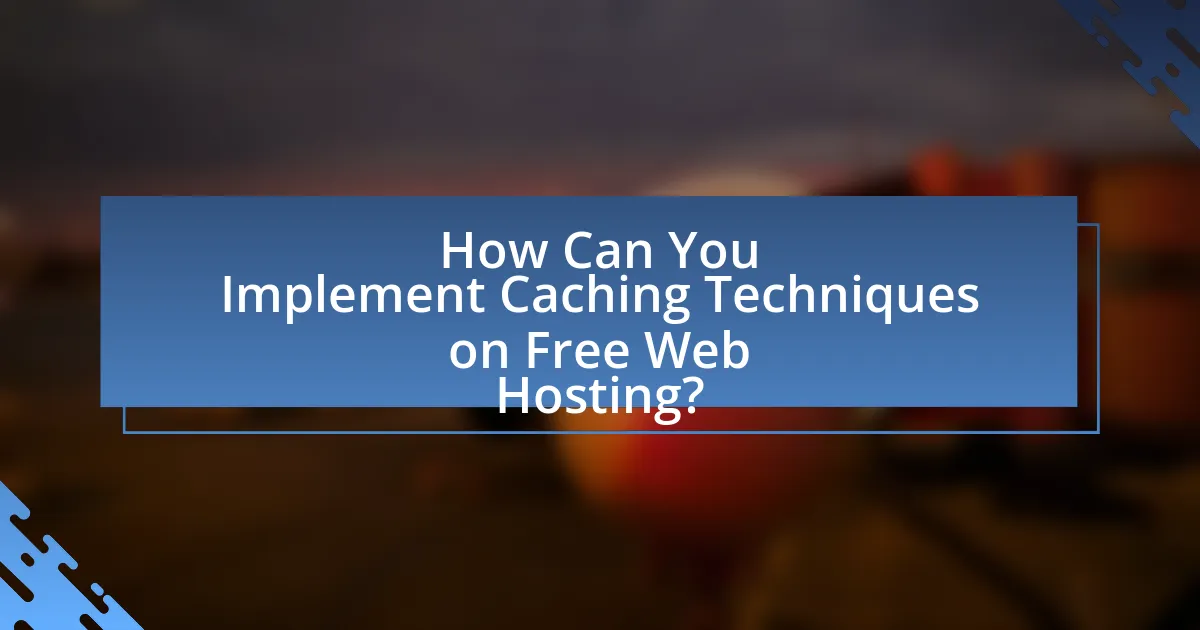The article focuses on advanced caching techniques for maximizing performance on free web hosting platforms. It outlines various caching methods, including browser caching, server-side caching, and content delivery networks (CDNs), explaining how these techniques enhance website speed and reduce server load. Key benefits of caching, such as improved response times and user experience, are discussed, along with effective implementation strategies and common pitfalls to avoid. The article emphasizes the importance of caching in optimizing resource usage, particularly in environments with limited hosting capabilities.

What are Advanced Caching Techniques for Free Web Hosting?
Advanced caching techniques for free web hosting include browser caching, server-side caching, and content delivery networks (CDNs). Browser caching allows users’ browsers to store static files, reducing load times on subsequent visits. Server-side caching, such as object caching and page caching, minimizes database queries and speeds up content delivery by storing pre-rendered pages or frequently accessed data. CDNs distribute content across multiple servers globally, ensuring faster access for users regardless of their location. These techniques collectively enhance website performance, even on free hosting platforms, by optimizing resource usage and reducing latency.
How do caching techniques improve performance on free web hosting?
Caching techniques significantly improve performance on free web hosting by reducing server load and decreasing page load times. When a website utilizes caching, frequently accessed data is stored temporarily, allowing subsequent requests for that data to be served quickly from the cache rather than requiring a full server response. This is particularly beneficial in free web hosting environments, where server resources are limited and can lead to slower performance under high traffic conditions. Studies have shown that implementing caching can lead to performance improvements of up to 70%, as it minimizes the need for repeated database queries and reduces the time taken to generate web pages.
What types of caching are most effective for free web hosting?
The most effective types of caching for free web hosting are browser caching, page caching, and object caching. Browser caching stores static files in the user’s browser, reducing load times for repeat visits. Page caching saves the entire HTML output of a page, allowing faster delivery without generating the page dynamically each time. Object caching stores database query results, minimizing the need for repeated database access, which is crucial in environments with limited resources. These caching methods significantly enhance performance by reducing server load and improving response times, making them ideal for free web hosting scenarios where resources are constrained.
How does caching reduce server load and improve response times?
Caching reduces server load and improves response times by storing frequently accessed data in a temporary storage location, allowing for quicker retrieval without needing to access the primary database or server each time. This process minimizes the number of requests made to the server, thereby decreasing CPU and memory usage. For instance, a study by Akamai Technologies found that caching can reduce server response times by up to 50%, significantly enhancing user experience and reducing latency. By serving cached content directly to users, the server can handle more simultaneous requests, leading to improved overall performance and efficiency.
Why is caching important for websites on free hosting platforms?
Caching is important for websites on free hosting platforms because it significantly enhances loading speed and reduces server load. Free hosting services often have limited resources, making them susceptible to performance issues during high traffic. By storing frequently accessed data temporarily, caching minimizes the number of requests sent to the server, which can lead to faster page loads and a better user experience. Studies show that a one-second delay in page response can lead to a 7% reduction in conversions, highlighting the critical role of caching in maintaining site performance under constrained conditions.
What challenges do free web hosting users face without caching?
Free web hosting users face significant performance challenges without caching, primarily due to slower load times and increased server strain. Without caching, every request for a webpage requires the server to process the request from scratch, leading to longer response times. This inefficiency can result in a poor user experience, as studies show that a one-second delay in page load time can lead to a 7% reduction in conversions. Additionally, free hosting services often have limited resources, and without caching, the server may become overwhelmed during peak traffic periods, causing downtime or errors. This lack of reliability can deter users from returning to the site, negatively impacting overall engagement and traffic.
How can caching enhance user experience on free web hosting sites?
Caching can significantly enhance user experience on free web hosting sites by reducing load times and improving site responsiveness. When a website utilizes caching, frequently accessed data is stored temporarily, allowing for quicker retrieval on subsequent visits. This leads to faster page loads, which is crucial for retaining users, as studies show that a one-second delay in page response can result in a 7% reduction in conversions. Additionally, caching minimizes server load, which is particularly beneficial for free hosting services that often have limited resources. By optimizing resource usage, caching ensures a smoother experience for users, even during peak traffic times.

What are the Different Types of Caching Techniques?
The different types of caching techniques include memory caching, disk caching, database caching, and proxy caching. Memory caching stores data in RAM for quick access, significantly speeding up data retrieval processes. Disk caching involves storing frequently accessed data on disk drives, which is slower than memory but allows for larger data storage. Database caching optimizes database query performance by storing query results, reducing the need for repeated database access. Proxy caching, often used in web environments, stores copies of web content closer to users, decreasing load times and bandwidth usage. Each technique enhances performance by reducing latency and improving data access speeds.
What is browser caching and how does it work?
Browser caching is a mechanism that stores web page resources in a user’s browser to improve load times and reduce server requests. When a user visits a website, the browser saves elements such as images, scripts, and stylesheets locally. On subsequent visits, the browser retrieves these resources from its cache instead of downloading them again from the server, resulting in faster page loading and reduced bandwidth usage. This process is governed by HTTP headers like Cache-Control and Expires, which dictate how long resources should be stored. Studies show that effective browser caching can decrease load times by up to 80%, significantly enhancing user experience and site performance.
How can browser caching be implemented effectively?
Browser caching can be implemented effectively by utilizing HTTP headers such as Cache-Control, Expires, and ETag to instruct the browser on how to store and retrieve resources. Setting Cache-Control to “public, max-age=31536000” for static assets allows browsers to cache these files for one year, reducing server requests and improving load times. Additionally, using the Expires header can specify an exact date and time for when the cached resource should be considered stale. Implementing ETags helps in validating cached resources by providing a unique identifier for each version of a resource, ensuring that browsers only download updated files when necessary. These methods collectively enhance performance by minimizing data transfer and speeding up page load times.
What are the benefits of browser caching for free web hosting?
Browser caching significantly enhances the performance of free web hosting by storing static resources locally on a user’s device, which reduces load times for subsequent visits. This mechanism minimizes the need for repeated requests to the server, thereby decreasing bandwidth usage and server load. As a result, websites can load faster, improving user experience and engagement. Studies indicate that faster load times can lead to higher conversion rates, with a 1-second delay potentially reducing conversions by 7%. Thus, implementing browser caching is a crucial strategy for optimizing the efficiency of free web hosting services.
What is server-side caching and why is it beneficial?
Server-side caching is a technique where data is stored on the server to reduce the time it takes to access frequently requested information. This method enhances performance by minimizing the need to generate responses from scratch for each user request, thereby decreasing server load and response times. For instance, according to a study by Google, implementing caching can improve page load times by up to 80%, significantly enhancing user experience and reducing bounce rates.
How does server-side caching differ from client-side caching?
Server-side caching stores data on the server, allowing multiple users to access the same cached content, while client-side caching stores data on the user’s device, enabling faster access for that specific user. Server-side caching reduces server load and improves response times for all users by serving cached data directly from the server, whereas client-side caching enhances user experience by minimizing data retrieval times for individual users, as the content is loaded from their local storage. This distinction is crucial for optimizing performance, especially in scenarios with high traffic, where server-side caching can significantly alleviate server strain, while client-side caching can enhance the speed of repeated visits for users.
What tools can be used for server-side caching on free hosting?
Server-side caching tools that can be used on free hosting include Varnish Cache, Memcached, and Redis. Varnish Cache is a web application accelerator that caches HTTP responses, significantly improving load times. Memcached is a distributed memory caching system that speeds up dynamic web applications by alleviating database load. Redis, an in-memory data structure store, can also be utilized for caching purposes, providing high performance for data retrieval. These tools are commonly supported by various free hosting providers, enhancing performance without incurring additional costs.

How Can You Implement Caching Techniques on Free Web Hosting?
To implement caching techniques on free web hosting, utilize browser caching, server-side caching, and content delivery networks (CDNs). Browser caching can be achieved by setting appropriate HTTP headers to instruct browsers to store static resources like images and stylesheets, reducing load times for repeat visitors. Server-side caching can be implemented using lightweight caching plugins or scripts that store frequently accessed data in memory, minimizing database queries. Additionally, integrating a CDN can enhance performance by distributing cached content across multiple servers globally, allowing users to access data from a location closer to them. These methods collectively improve website speed and efficiency, even on limited hosting resources.
What steps should be taken to set up caching on a free web host?
To set up caching on a free web host, first, check if the hosting provider supports caching mechanisms like Varnish or built-in caching options. If supported, enable the caching feature through the hosting control panel. Next, configure caching rules, specifying which files or data should be cached to optimize performance. Additionally, implement a caching plugin if using a content management system like WordPress, as these plugins simplify the caching process. Finally, test the website’s performance using tools like Google PageSpeed Insights to ensure caching is functioning effectively. This approach is validated by the fact that proper caching can significantly reduce load times and improve user experience, as evidenced by studies showing that faster websites lead to higher user engagement and retention.
What configurations are necessary for effective caching?
Effective caching requires specific configurations such as setting appropriate cache expiration times, enabling cache compression, and utilizing cache hierarchies. Cache expiration times dictate how long cached content remains valid, which can significantly impact performance; for instance, a shorter expiration time may lead to more frequent updates but can reduce load times for frequently accessed data. Enabling cache compression reduces the size of cached files, improving transfer speeds and reducing bandwidth usage. Additionally, implementing cache hierarchies, such as using a combination of browser caching, server-side caching, and CDN caching, optimizes resource delivery by ensuring that content is served from the closest and most efficient source. These configurations collectively enhance the efficiency and effectiveness of caching strategies.
How can you test the effectiveness of your caching setup?
To test the effectiveness of your caching setup, you can use performance monitoring tools to measure response times and resource usage before and after implementing caching. Tools like Apache Benchmark or JMeter can simulate traffic and provide metrics on how caching reduces load times and server strain. For instance, a study by Google indicated that a 100-millisecond delay in load time can reduce conversions by 7%, highlighting the importance of effective caching in improving performance.
What common pitfalls should be avoided when using caching?
Common pitfalls to avoid when using caching include improper cache invalidation, excessive caching, and neglecting cache size limits. Improper cache invalidation can lead to stale data being served, which undermines the reliability of the application. Excessive caching can consume unnecessary memory resources, potentially degrading performance rather than enhancing it. Additionally, neglecting cache size limits can result in cache overflow, causing the system to revert to slower data retrieval methods. These pitfalls can significantly impact application performance and user experience, making it crucial to implement effective caching strategies.
How can misconfigured caching lead to issues on your website?
Misconfigured caching can lead to significant issues on your website by serving outdated or incorrect content to users. When caching settings are improperly configured, users may experience stale data, such as old versions of web pages or outdated product information, which can result in confusion and a poor user experience. Additionally, misconfigured caching can cause performance bottlenecks, as the server may struggle to retrieve fresh content when needed, leading to increased load times and potential downtime. According to a study by Google, a one-second delay in loading time can lead to a 20% decrease in conversions, highlighting the critical impact of caching misconfigurations on website performance and user engagement.
What are the best practices for maintaining cache performance?
To maintain optimal cache performance, implement strategies such as regularly purging stale cache entries, optimizing cache size, and using appropriate cache expiration policies. Regularly purging stale entries ensures that outdated data does not consume resources, which can lead to inefficiencies. Optimizing cache size involves adjusting the cache to fit the workload, preventing over-allocation that can slow down performance. Additionally, employing appropriate expiration policies, such as time-based or event-based expiration, helps in managing the freshness of cached data, ensuring that users receive the most relevant information without unnecessary delays. These practices are supported by studies indicating that effective cache management can significantly enhance application responsiveness and reduce server load.
What are some practical tips for maximizing caching performance?
To maximize caching performance, implement strategies such as optimizing cache size, using appropriate cache expiration policies, and leveraging content delivery networks (CDNs). Optimizing cache size ensures that frequently accessed data remains available, while appropriate expiration policies prevent stale data from being served, thus maintaining data accuracy. Leveraging CDNs can significantly reduce latency by caching content closer to users, improving load times. According to a study by Akamai, using a CDN can improve website performance by up to 50%, demonstrating the effectiveness of these caching techniques.


